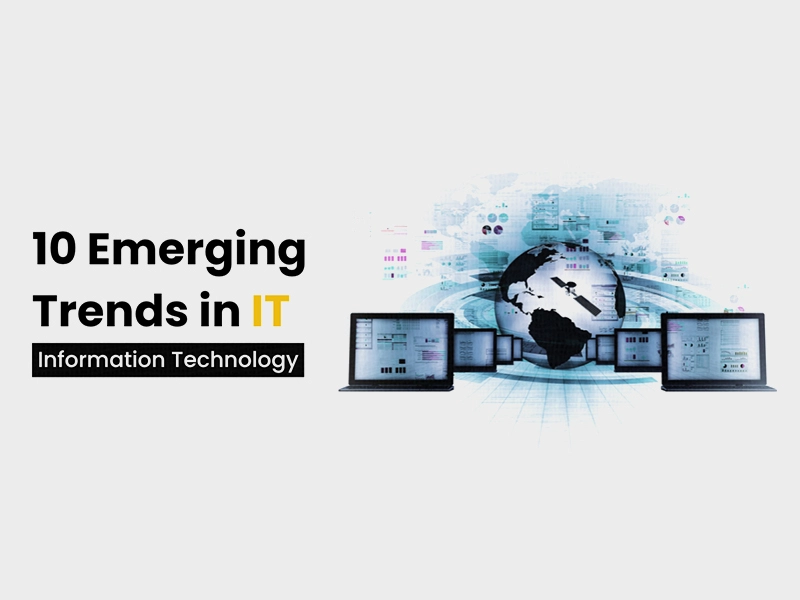21st century has been defined by application of and advancement in information technology. Information technology has become an integral part of our daily life. According to Information Technology Association of America, information technology is defined as “the study, design, development, application, implementation, support or management of computer-based information systems.”
Staying current with industry trends is essential for staying competitive in today’s job market. Keeping up with the latest developments and technologies in your field can help you stand out to potential employers as a valuable asset. By staying current with industry trends, you can improve your chances of landing a job, or being considered for a promotion and increase your earning potential. It also makes you more valuable to your current employer, which can increase your chances of securing a raise or other benefits.
II. Artificial Intelligence (AI) Revolutionizing IT
Artificial Intelligence plays a crucial role in Revolutionizing Informative Technology. AI continues to push the boundaries of what is possible in IT, and its transformative impact is likely to accelerate further in the future. The field of Information Technology (IT) has been revolutionized by the transformative role of machine learning advancements. Significant progress in Artificial Intelligence (AI) has resulted in improved efficiency, enhanced decision-making, and the emergence of innovative applications within IT.
Some keys ways in which machine learning advancements have revolutionized IT:
- Data Analysis and Insights
- Predictive maintenance
- Cybersecurity and Fraud Detection
- Automation and Robotic Process Automation(RPA)
- Personsalized User Experience
- Intelligent Data Management
AI has revolutionized robotics and automation by enabling intelligent control, autonomous navigation, collaborative robots, machine vision, task automation, machine learning for robot learning, and intelligent decision-making. These advancements have made robots smarter, more efficient, and capable of adapting to dynamic environments.
III. Big Data and Analytics:
Big data is defined as data sets whose size or type is beyond the ability of traditional relational databases to capture, manage and process the data with low latency.
The collection, processing, and interpretation of vast amounts of data have been revolutionized by Big Data and analytics. Through the integration of advanced technologies and analytical methods, organizations can leverage data to make informed decisions, gain a competitive edge, and uncover valuable insights.
Data analytics plays an essential role in delivering valuable business insights to organizations. Through the analysis of datasets, businesses can enhance their understanding of operations, customers, and market trends on a deeper level. Here are key aspects of data analytics and its role in generating business insights:
- Data collection and Preparation
- Descriptive Analytics
- Diagnostics Analytics
- Predictive Analytics
- Prescriptive Analytics
- Business Performance Monitoring
- Customer Insights and Personalization
- Risk management and Fraud detection
- Data-Driven Desicion making
Data privacy and security concerns hold utmost importance in today’s digital landscape. Organizations must adhere to data protection regulations, prevent data breaches, utilize techniques such as data anonymization, obtain user consent, secure data storage and transmission, provide employee training, manage third-party data sharing, adopt privacy by design principles, and implement comprehensive data lifecycle management practices. Prioritizing data privacy and security enables organizations to safeguard sensitive information, uphold customer trust, and mitigate risks associated with data breaches and cyber threats.
IV. Cloud Computing: The Future of IT Infrastructure:
Cloud computing is positioned to be the future of IT infrastructure, offering scalability, accessibility, cost-effectiveness, and enhanced security. It provides various services and models like IaaS, PaaS, SaaS, and FaaS, enabling flexibility and ease of access to computing resources. Cloud security and governance, including data protection, identity management, compliance, and risk management, are vital for ensuring a secure cloud environment. Cloud-native applications and microservices leverage the benefits of cloud computing for scalable and efficient software development. As technology evolves, cloud computing will continue to play a crucial role in helping businesses adapt quickly and fully utilize the potential of digital transformation.
V. Internet of Things (IoT) and Connected Devices
The Internet of Things (IoT) encompasses interconnected physical devices embedded with software, sensors, and connectivity, enabling data exchange. It facilitates the collection and sharing of data across a wide network of devices, leading to enhanced efficiency and automation in various systems.
The Internet of Things (IoT) has gained significant traction across various industries, transforming how businesses operate and deliver services. Different industries where IoT applications is in use are:
- Healthcare
- Manufacturing
- Agriculture
- Smart cities
- Retails
IoT generates vast amounts of data from connected devices, necessitating efficient management and analysis. Key considerations include reliable data collection, scalable storage solutions, integration of disparate data sources, advanced analytics techniques, robust security measures, and compliance with regulations. Effective IoT data management and analysis enable organizations to extract valuable insights, optimize processes, and develop innovative services while ensuring data security and privacy.
VI. Cybersecurity in the Age of Digital Transformation
Cybersecurity is crucial in the era of digital transformation to protect organizations from evolving threats. Cybercriminals employ sophisticated techniques, making it essential to adopt robust security measures. Next-generation security technologies like advanced threat intelligence and machine learning play a vital role. The Zero Trust framework challenges traditional notions of trust and emphasizes continuous authentication and authorization. By prioritizing cybersecurity and implementing these measures, organizations can navigate the digital landscape securely and safeguard their assets.
VII. 5G Technology: Enabling a Connected World
5G networks represent the latest generation of wireless technology, bringing significant advancements such as speed, capacity, and low latency. It has the potential to transform various industries, including telecommunications, healthcare, transportation, and manufacturing, by enabling highly interconnected and innovative experiences. The implementation of 5G has notable impacts on:
- IT infrastructure
- Including increased capacity and speed
- Integration with edge computing and the Internet of Things (IoT)
- Enhanced security measures.
However, there are challenges involved in deploying 5G infrastructure, including complexity, cost, spectrum availability, compatibility issues, and privacy concerns. Despite the challenges, the opportunities presented by 5G are substantial, and its implementation requires collaboration, technological integration, and careful consideration of data protection and privacy regulations.
VIII. Augmented Reality (AR) and Virtual Reality (VR)
Augmented Reality (AR) and Virtual Reality (VR) are immersive technologies that have gained significant traction in recent years. They offer unique experiences by blending the virtual and real worlds.
Augmented Reality (AR) overlays digital content onto the real world, enhancing user interaction and perception. It is used in mobile apps, retail for virtual try-on, interactive training simulations, and real-time data overlays in industrial applications.
Virtual Reality (VR) creates a simulated environment that immerses users in a virtual world. VR applications include gaming, virtual tours, training and education simulations, virtual meetings and conferences, and therapeutic interventions.
As technology continues to advance, the applications of AR and VR in various industries and sectors will expand. From enhancing customer experiences to improving training and collaboration, AR and VR have the potential to transform how businesses operate and interact with their audiences.
IX. Quantum Computing: The Frontier of Computing Power
Quantum mechanics is a fundamental theory in physics that describes the behavior of particles at the microscopic level. Quantum mechanics forms the foundation for many technological advancements, including quantum computing, quantum cryptography, and quantum communication.
Quantum computing is an emerging field that utilizes the principles of quantum mechanics to perform computations. Some potential applications of quantum computing are:
- Cryptography and data security
- Optimization and simulation
- Machine learning and artificial intelligence
- Quantum chemistry
- Financial modeling and risk analysis
- Quantum communication
X. Blockchain Technology and Decentralization
Blockchain is a secure and transparent digital ledger that records transactions and eliminates the need for intermediaries. It is widely used in finance, supply chain, healthcare, and other industries. While often associated with cryptocurrencies, blockchain has various applications beyond them. Its features have contributed to the popularity of cryptocurrencies, but it also enables other innovative uses. In fact, there is widespread adoption of blockchain in several different industries which are:
- Supply chain management
- Cyber security
- Voting
- Financial services
- Loyalty reward programs
XI. The Evolution of User Experience (UX) Design
UX principles and user-centered design prioritize user needs and satisfaction, aiming to create user-friendly experiences through research, usability, consistency, feedback, and accessibility. Omnichannel experience ensures a seamless customer journey across channels, while personalization tailors the experience to individual preferences. Combining these concepts allows businesses to create cohesive, engaging, and personalized experiences that boost customer satisfaction and loyalty.


















